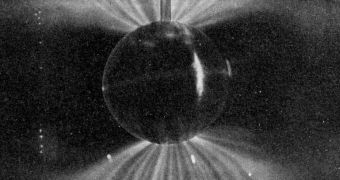According to a new scientific study, it would appear that solar winds in fact contain significantly higher amounts of oxygen within than anyone believed was possible. The research was recently published in a top scientific journal.
Though astronomers have known for quite some time that the Sun is rich in oxygen supplies itself, they were never able to measure with too much accuracy the actual amounts of the chemical that are present on the star itself.
This lack of knowledge allows for surprises such as the one in the new study to fall in the lap of research scientists. When it comes to studying stars, generally speaking, hydrogen and helium are the main elements scientists are trying to analyze, not oxygen.
But researcher Rudolf von Steiger, who is based at the International Space Science Institute, in Bern, Switzerland, decided to investigate the oxygen issue in great detail, and started looking over long-term data to do so.
Together with a team of colleagues, the scientist analyzed data collected by the Ulysses spacecraft, which was jointly designed and operated by NASA and the European Space Agency (ESA).
The probe took off during space shuttle Discovery's STS-41 mission, on October 6, 1990. Its main mission was to study the Sun at all latitudes, and for this very purposes it did a flyby of Jupiter.
The maneuver allowed it to change its orbit around the star. Limitations in technology did not allow for the spacecraft to change its orbit while in the inner solar system. The space probe ended its mission on June 30 2009, after 18 years and 9 months of operation.
Steiger and his colleagues used data collected by the instrument suite on Ulysses to keep track of the flux of oxygen ions (electrically charged atoms) coming from the Sun, the flux of protons emanating from the star, as well as the ratio between the two.
In a paper appearing in the latest issue of the esteemed scientific journal Geophysical Research Letters (GRL), the team determined that the solar oxygen abundance is in fact higher than any other studies proposed before.
Knowing this value precisely is important because it has implications for the field of helioseismology, which is the science dealing with quakes forming on stars, SpaceRef reports.
A more in-depth understanding of the role oxygen plays in the Sun and other stars is also important for understanding the chemical evolution of the galaxy and of our solar system.
Also contributing to the work were University of Michigan Department of Atmospheric, Oceanic and Space Sciences expert Thomas H. Zurbuchen and Southwest Research Institute (SwRI) Space Science and Engineering Division expert David J. McComas, among others.

 14 DAY TRIAL //
14 DAY TRIAL //